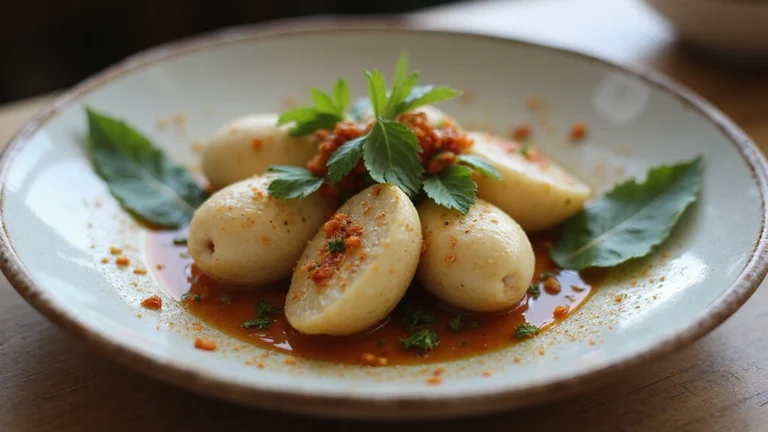
Looking for a miso chili recipe that’ll revolutionize your dinner table? This flavor-packed dish combines the umami richness of Japanese miso with the bold spices of traditional chili for a fusion that’s impossible to resist.
Miso chili brings together two culinary worlds in perfect harmony. The fermented soybean paste adds depth and complexity to the hearty beans and vegetables, while traditional chili spices provide that familiar comfort food appeal. It’s a versatile dish that works equally well for casual weeknight dinners or impressing guests at your next gathering.
You’ll love how this recipe balances savory, spicy, and slightly sweet notes in every bite. The miso paste not only enhances flavor but also adds nutritional benefits, making this chili as nourishing as it is delicious.
What Makes This Miso Chili Special
This miso chili stands apart from traditional recipes through its unique fusion of Eastern and Western culinary traditions. The addition of miso paste introduces a complex umami foundation that transforms ordinary chili into something extraordinary.
Unlike conventional chili recipes that rely solely on tomato-based acidity and chili heat, this version leverages miso’s fermented richness to create depth without overwhelming the palate. The subtle sweetness and savory notes of miso balance perfectly with the warming spices typically found in chili.
Texture plays a crucial role in this dish’s appeal. The velvety miso melts seamlessly into the sauce, creating a silky mouthfeel that coats each bean and vegetable piece. This smooth consistency contrasts beautifully with the hearty chunks of vegetables and protein.
Nutritionally, this chili offers advantages beyond taste. Miso contains beneficial probiotics that support gut health and enhance digestion. The fermentation process also makes nutrients more bioavailable, increasing the overall nutritional value of your meal.
Versatility sets this recipe apart as well. You can easily adjust the miso quantity to control saltiness and umami intensity. The dish works perfectly with various proteins including beef, turkey, chicken or plant-based alternatives for vegans and vegetarians.
The cooking method allows the flavors to develop gradually, creating a multi-dimensional taste experience that continues to evolve as the chili simmers. This makes it ideal for batch cooking as the flavors often improve after a day in the refrigerator.
Ingredients For Miso Chili
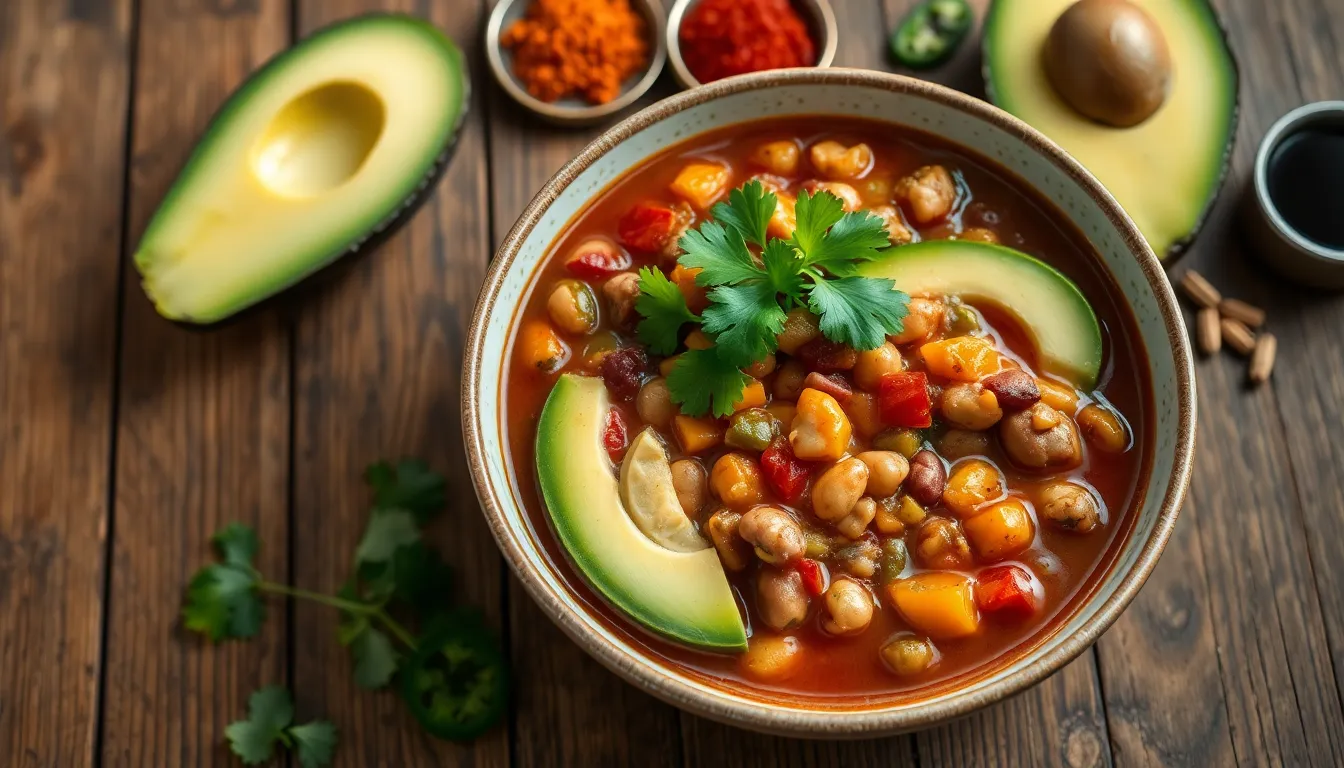
Creating this fusion dish requires a thoughtful blend of traditional chili ingredients with the umami richness of Japanese miso paste. Here you’ll find everything needed to create a perfect pot of miso chili that balances savory depth with satisfying textures.
Protein Components
-
Beans (choose 2-3 varieties):
- Kidney beans (1 can drained and rinsed)
- Great Northern beans (1 can drained and rinsed)
- Chickpeas (1 can drained and rinsed)
- Black beans (1 can drained and rinsed)
-
Meat options (for non-vegan version):
- Ground beef (1 pound)
- Ground pork (1 pound)
The protein foundation provides substantial texture and heartiness to your chili. You can use all beans for a robust vegan version or incorporate ground meat for a more traditional chili con carne approach.
Vegetables And Aromatics
-
Base aromatics:
- 1 large shallot or small onion (finely diced)
- 4-6 garlic cloves (minced)
- 1-2 jalapeños (seeds removed and diced for moderate heat)
-
Vegetables:
- 1 Anaheim or poblano chile (diced)
- 1 bunch kale or chard (stems removed chopped)
- 1 cup corn kernels (fresh or frozen)
- 2 medium potatoes (diced into ½-inch cubes)
- 1 can (28 oz) crushed tomatoes
Sautéing the aromatics first builds the essential flavor foundation for your chili. The vegetables add nutritional value texture and colorful appeal while balancing the richness of the miso and proteins.
Miso And Seasonings
-
Miso:
- 3-4 tablespoons white miso paste
-
Spices and flavor enhancers:
- 2 tablespoons ground cumin
- 2-3 tablespoons chili powder or ancho chile powder
- ¼ teaspoon nutmeg
- 2 tablespoons natural creamy peanut butter (optional for depth)
- 3 cups vegetable broth
- Salt and pepper to taste
White miso paste delivers the signature umami character that distinguishes this chili from traditional recipes. The combination of familiar chili spices with miso creates a complex flavor profile that develops beautifully during cooking.
Optional Toppings
- Dairy or plant-based yogurt
- Sour cream
- Sliced avocado
- Chopped fresh cilantro
- Sliced green onions
- Shredded cheese
- Lime wedges
- Crushed tortilla chips
Toppings allow for personalization at serving time. Cool creamy additions like yogurt or avocado balance the chili’s warmth while fresh herbs and crunchy elements add textural contrast to each bowl.
Equipment Needed
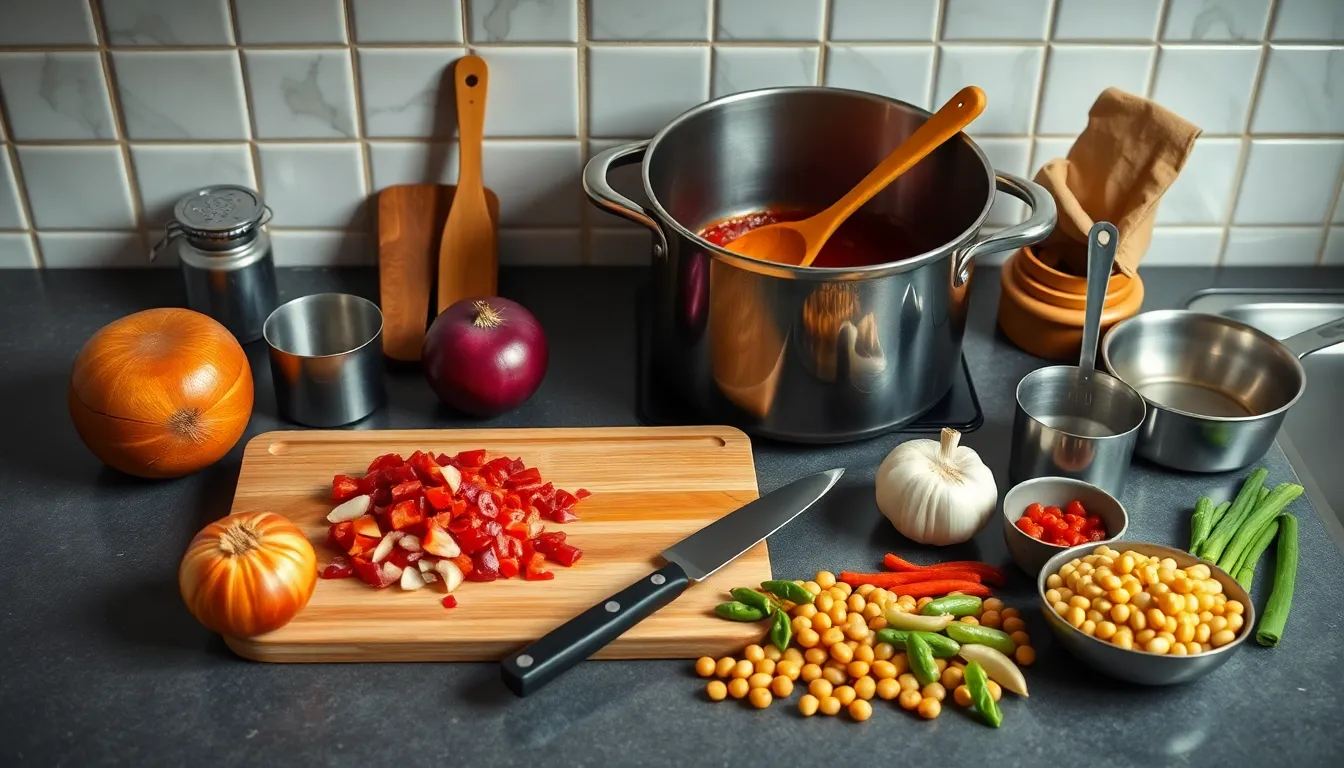
Preparing miso chili requires just a few basic kitchen tools that most home cooks already have on hand. The simplicity of equipment needed makes this recipe accessible for cooks of all experience levels.
- Large pot or Dutch oven – A heavy-bottomed pot with at least 4-6 quart capacity provides ample space for sautéing aromatics and simmering the chili to perfection
- Wooden spoon or heat-resistant spatula – Essential for stirring ingredients and preventing them from sticking to the bottom of the pot
- Sharp chef’s knife – For efficiently dicing onions, mincing garlic, and chopping any vegetables you choose to include
- Cutting board – Provides a stable surface for all your ingredient preparation
- Measuring spoons and cups – For accurately portioning the miso paste, spices, and other ingredients
- Potato masher (optional) – Useful if you prefer to thicken your chili by partially mashing some of the beans
- Ladle – For serving the finished chili into bowls
- Small bowl – Helpful for dissolving the miso paste with a bit of broth before adding it to the main pot
The beauty of miso chili lies in its straightforward preparation process that doesn’t demand specialized equipment. Your standard kitchen setup will serve you well for creating this umami-rich dish with minimal fuss and maximum flavor.
How To Make Miso Chili

Creating this umami-rich fusion dish is simpler than you might think. Follow these step-by-step instructions to bring together the perfect blend of traditional chili spices and Japanese miso flavors.
Preparing The Vegetables
Heat 2 tablespoons of oil in a large pot over medium heat. Dice one medium onion or 2-3 shallots and add them to the hot oil, sautéing until they become translucent and tender (about 5 minutes). Add 3-4 cloves of minced garlic and your choice of diced fresh chiles—Anaheim peppers offer mild heat while jalapeños provide more kick. Cook these aromatics together for an additional 2 minutes until fragrant. This foundational step creates the aromatic base that will carry through your entire chili.
Building The Base Flavors
Sprinkle 2 tablespoons of cumin, 2 tablespoons of chili powder or ancho chile powder, and 1 teaspoon of black pepper into your vegetable mixture. Stir constantly for about 30 seconds to toast the spices and release their essential oils. Add your beans of choice (2 cans of kidney beans, chickpeas, white beans, or black beans, drained and rinsed). Incorporate diced vegetables like kale, chard, or potatoes for additional texture and nutritional value. These ingredients form the hearty backbone of your chili while complementing the upcoming miso addition.
Adding The Miso Element
Take 1-2 tablespoons of white miso paste and dissolve it in a small amount of warm broth or water. Pour this miso mixture into your pot and stir thoroughly to ensure even distribution throughout the chili base. White miso offers a mild slightly sweet flavor that enhances rather than overwhelms the traditional chili profile. For additional complexity consider adding 1 tablespoon of peanut butter or a splash of mirin or sake. The miso element transforms ordinary chili into something extraordinary by contributing a deep umami richness that balances perfectly with the spicy components.
Simmering To Perfection
Pour in one 28-ounce can of crushed tomatoes and 2-3 cups of vegetable or meat broth. Bring everything to a gentle boil then reduce the heat to maintain a steady simmer. Let the chili cook uncovered for 15-30 minutes allowing the flavors to meld together and the liquid to reduce slightly. Stir occasionally to prevent sticking. If you prefer a thicker consistency use a potato masher to crush some of the beans during the cooking process. Taste and adjust the seasoning with salt and pepper after the simmering period is complete. Your miso chili is ready when it reaches your desired thickness and the vegetables are tender.
Serve hot with your favorite toppings like sour cream yogurt avocado slices or fresh herbs. The combination of spicy heat savory depth from miso and hearty textures creates a uniquely satisfying twist on traditional chili.
Tips For The Best Miso Chili

Elevate your miso chili from good to extraordinary with these expert techniques that highlight the unique umami characteristics of this fusion dish.
Master the Miso Integration
Introduce miso paste toward the end of sautéing your aromatics and spices rather than at the beginning. First dilute it with a small amount of warm broth in a separate bowl to prevent clumping. This technique preserves the delicate umami flavor that can diminish with prolonged cooking. White miso offers a milder flavor profile that works beautifully in chili without overwhelming other ingredients.
Build Layers of Flavor
Start your chili by properly sautéing aromatics over medium heat. Allow shallots or onions to soften with chiles until they become translucent and fragrant before adding garlic. This creates a robust flavor foundation that supports the miso addition. Toast your spices in the oil with the aromatics for 30-60 seconds to release their essential oils and enhance their potency.
Perfect Your Texture
Adjust the consistency of your chili to suit your preference by varying the amount of broth you add. For a naturally thicker chili without additives, mash approximately one-quarter of your beans with a potato masher or the back of a wooden spoon. This technique creates a creamier base while maintaining plenty of whole beans for textural contrast.
Select Quality Ingredients
Use unsalted vegetable stock as your liquid base to maintain control over the final saltiness of your dish. Since miso paste contains important sodium, starting with unsalted broth prevents overseasoning. Choose fresh chiles like Anaheim or poblano for authentic flavor rather than relying solely on dried spices.
Simmer Strategically
After combining all ingredients, bring your chili to a gentle boil before reducing to a simmer for 15-20 minutes. This timing allows flavors to meld while preventing vegetables from becoming mushy. The beans should remain intact yet tender. Stir occasionally to prevent sticking and distribute heat evenly throughout the pot.
Balance Flavors
Taste your chili before serving and adjust seasonings as needed. If it tastes flat, add a small splash of vinegar or squeeze of lime to brighten flavors. For additional richness, consider stirring in a tablespoon of peanut butter which complements the miso’s umami qualities while adding subtle creaminess to the finished dish.
Consider Timing and Storage
Prepare your miso chili a day ahead when possible. The flavors continue developing overnight in the refrigerator, resulting in a more complex and harmonious dish when reheated. When storing leftovers, cool completely before refrigerating for up to 4 days or freezing for up to 3 months in airtight containers.
Serving Suggestions
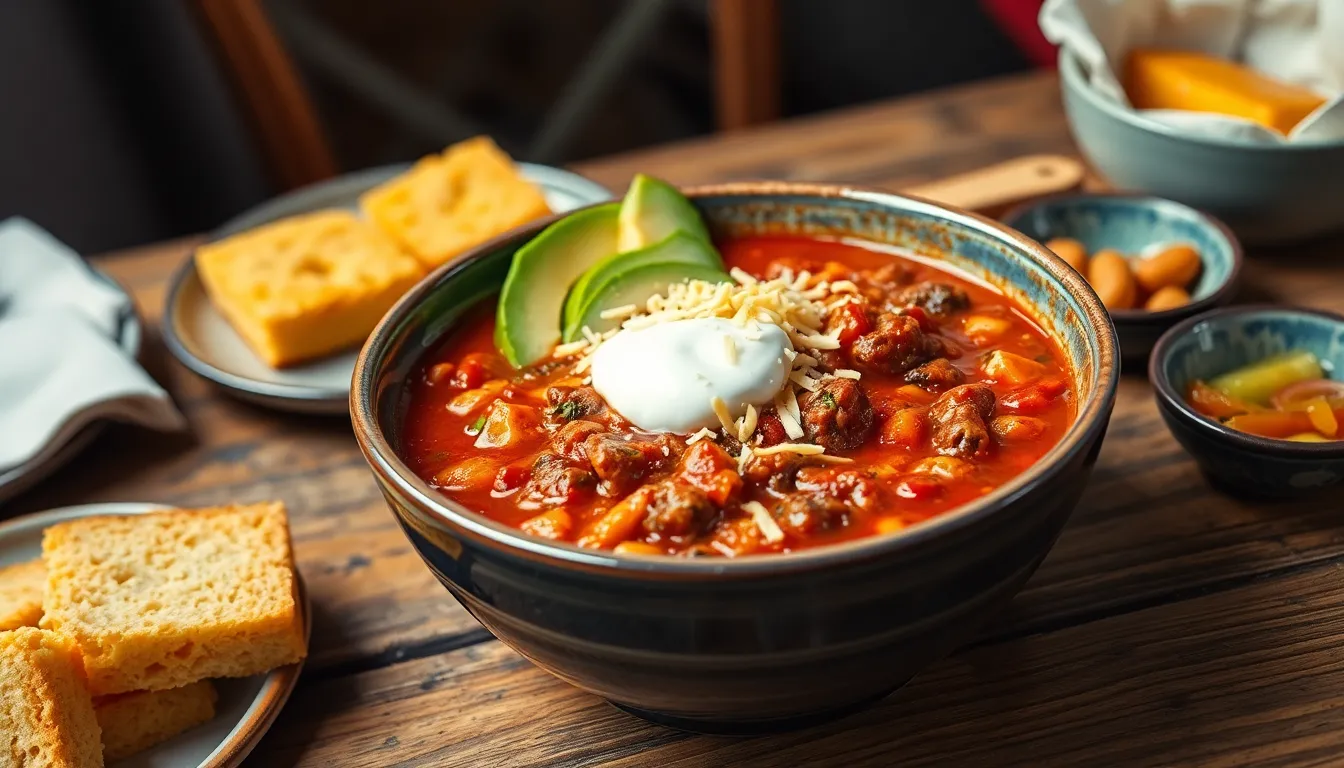
Transform your miso chili from a simple meal to a memorable dining experience with these creative serving ideas. The umami-rich flavor profile of this fusion dish pairs beautifully with various accompaniments that enhance its complex taste.
Classic Comfort Approach
Ladle your steaming miso chili into deep bowls and top with a dollop of tangy yogurt or sour cream to balance the heat. Slices of creamy avocado provide a cool contrast while adding healthy fats to your meal. Sprinkle shredded cheese that melts slightly into the hot chili creating irresistible cheese pulls with each spoonful.
Asian-Inspired Presentation
Serve your miso chili over a bed of steamed short-grain rice for an Asian twist that honors the Japanese origins of miso. Drizzle with additional miso chili oil for those who enjoy extra heat and umami depth. Garnish with thinly sliced green onions and toasted sesame seeds to add freshness and texture to each bite.
Bread Companions
Offer warm cornbread on the side for a traditional chili pairing that works wonderfully with the miso variation. Crusty sourdough bread makes an excellent vehicle for sopping up the flavorful sauce. For a fusion approach try serving with mantou (Chinese steamed buns) or pillowy naan bread that complement the umami notes.
Family-Style Serving
Create a build-your-own chili bar for gatherings by placing the miso chili in a large pot at the center of the table surrounded by bowls of toppings. Include wasabi sour cream for adventurous eaters alongside traditional options like diced onions and cilantro. This interactive serving style encourages conversation while allowing guests to customize their portions.
Weekday Meal Prep
Transform leftover miso chili into completely new meals throughout the week. Use it as a savory filling for baked potatoes topped with green onions and cheese. Spoon it over nachos for a quick appetizer or game day snack. Mix with scrambled eggs for a protein-packed breakfast that jumpstarts your morning with complex flavors.
Light Accompaniments
Balance the heartiness of miso chili by serving it with a simple side salad dressed in rice vinegar and sesame oil. A small bowl of pickled vegetables offers palate-cleansing acidity between bites of rich chili. These lighter sides prevent the meal from feeling too heavy while adding nutritional variety.
Beverage Pairings
Complete your miso chili meal with beverages that stand up to its bold flavor profile. A cold Japanese lager or create IPA cuts through the richness with refreshing effervescence. Non-alcoholic options like sparkling water with citrus or unsweetened iced green tea provide similar cleansing effects without the alcohol.
Storage And Freezing Instructions
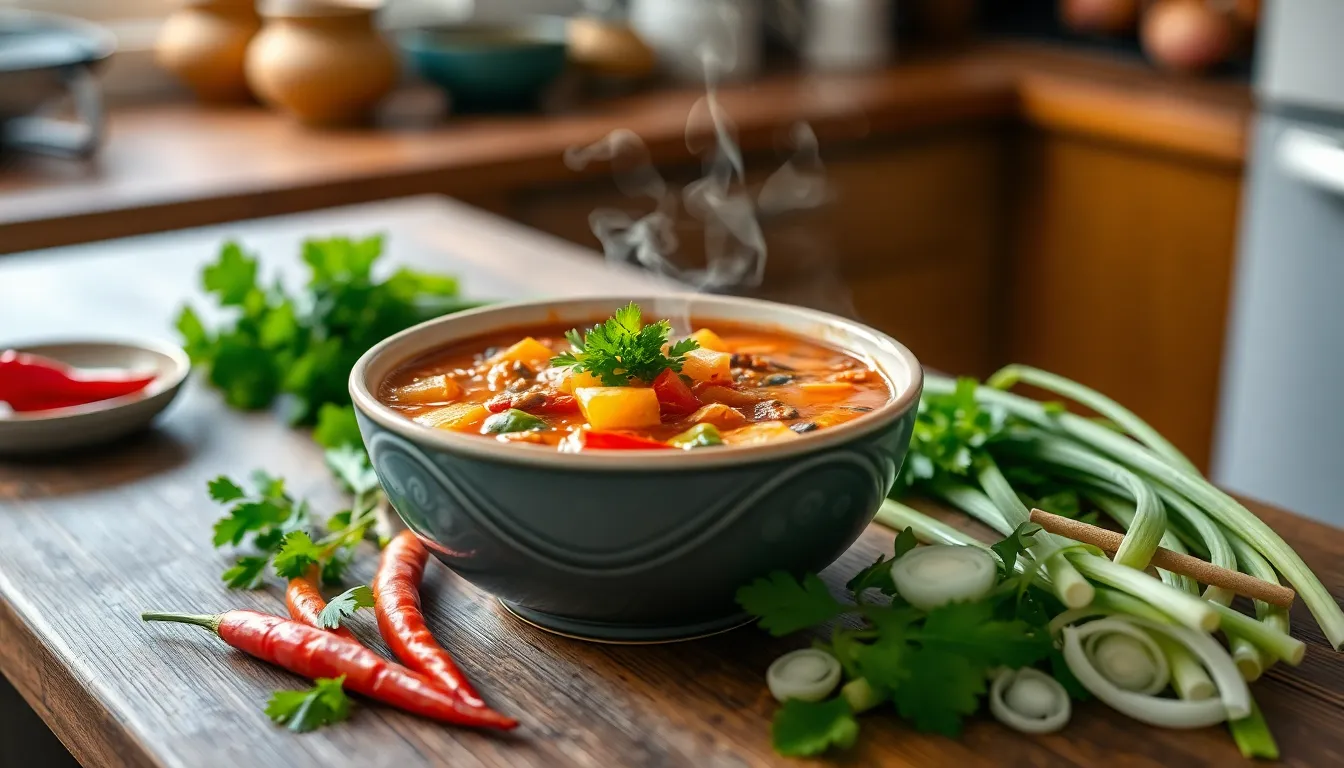
Proper storage of your miso chili ensures you’ll enjoy its complex flavors for days or even weeks after preparation. Follow these guidelines to maintain optimal taste and food safety.
Refrigerating Miso Chili
Allow your miso chili to cool completely before transferring it to airtight containers for refrigeration. Store the chili in the refrigerator for up to 2-3 weeks, though you’ll likely notice the best flavor within the first week. Before serving refrigerated chili, let it sit at room temperature for 10-15 minutes to enhance its flavor profile and texture.
Always use clean utensils when portioning out your refrigerated chili to prevent contamination. The umami-rich flavor from the miso paste actually develops further after a day or two in the refrigerator, making this dish perfect for meal prep.
Freezing For Long-Term Storage
Miso chili freezes exceptionally well due to the preservative qualities of miso paste. Here’s how to freeze it properly:
- Cool the chili completely before packaging
- Divide into portion-sized freezer-safe containers or heavy-duty freezer bags
- Leave about an inch of headspace in containers to allow for expansion
- Label with the date and contents
- Store in the freezer for up to 3 months
White miso-based chili tends to maintain its quality in the freezer for about 3 months, while recipes using darker miso varieties may last up to 6 months frozen without important loss of flavor.
Thawing And Reheating
For best results, thaw your frozen miso chili overnight in the refrigerator. If you’re short on time, you can place the sealed container in a bowl of cold water to speed up the process, changing the water every 30 minutes.
Reheat the chili gently in a pot over medium-low heat, stirring occasionally to ensure even warming. Adding a splash of water or broth helps revive the consistency if it appears too thick after storage. Miso’s probiotics are heat-sensitive, so avoid boiling the chili when reheating to preserve some of its nutritional benefits.
Signs Of Spoilage
Monitor your stored miso chili for any signs of spoilage before consuming. While miso itself is preservative, the other ingredients in your chili may deteriorate faster. Discard the chili if you notice:
- Off or sour smells
- Discoloration beyond normal oxidation
- Pink mold (white or green mold on pure miso paste can sometimes be removed, but in mixed dishes like chili, any mold presence warrants disposal)
- Unusual texture changes
Following these storage guidelines ensures your miso chili remains safe and delicious, allowing you to enjoy this flavorful fusion dish whenever the craving strikes.
Variations Of Miso Chili

Miso chili offers incredible versatility through its adaptable nature allowing you to customize it based on dietary preferences flavor profiles and available ingredients. Explore these popular variations to discover your perfect miso chili style.
Vegetarian Miso Chili
Transform your chili into a plant-based powerhouse by incorporating a variety of beans and vegetables. Start with a mixture of kidney beans chickpeas and Great Northern beans to create a hearty protein base. Add leafy greens like kale or chard to boost nutrition and texture while building flavor with cumin and chili powder. The white miso paste contributes essential umami depth that perfectly compensates for the absence of meat.
For added creaminess stir in a tablespoon of peanut butter which complements the miso while adding richness and complexity. Sauté onions garlic and mild chiles like Anaheim or poblano varieties to develop a flavorful foundation. Use vegetable stock as your liquid base allowing it to reduce and concentrate during simmering. Finish your vegetarian miso chili with fresh garnishes such as diced avocado a dollop of plant-based yogurt and chopped cilantro to elevate both presentation and flavor.
Spicy Miso Chili
Kick up the heat in your miso chili by incorporating multiple layers of spice. Begin with ancho chili powder for smoky depth then add regular chili powder for bright heat. Dice fresh Anaheim or poblano chiles and include them early in the cooking process to infuse their spiciness throughout the dish. White miso paste balances the intense heat with its savory umami qualities preventing the spice from overwhelming your palate.
Ground cumin toasted before adding liquids enhances the warm spice profile while a pinch of nutmeg adds surprising complexity. Adjust the spice level by controlling the amount of chili powder and fresh chiles based on your heat preference. The beauty of spicy miso chili lies in its balance between fiery heat and the deep savory notes from miso creating a dish that delivers both intensity and satisfaction without sacrificing flavor complexity.
Seafood Miso Chili
Create an innovative fusion dish by incorporating seafood into your miso chili for a unique East-meets-West experience. Begin with a base of white or red miso paste combined with traditional chili aromatics like onions and garlic. Add ground pork to establish a rich foundation then introduce seafood elements such as shrimp chunks of firm white fish or even scallops during the final cooking stage to prevent overcooking.
Canned tomatoes provide acidity that balances the richness of both the seafood and miso. The dish “Miso Chili Con Carne y Wasabi Sour Cream” exemplifies this variation with its combination of ground pork white miso and a spicy wasabi-infused sour cream topping. The umami qualities of miso naturally enhance the seafood flavors creating a harmonious blend of Tex-Mex spices and Asian-inspired depth. Serve this sophisticated variation with crusty bread or over steamed rice to absorb the flavorful broth created during cooking.
Perfect Pairings For Miso Chili
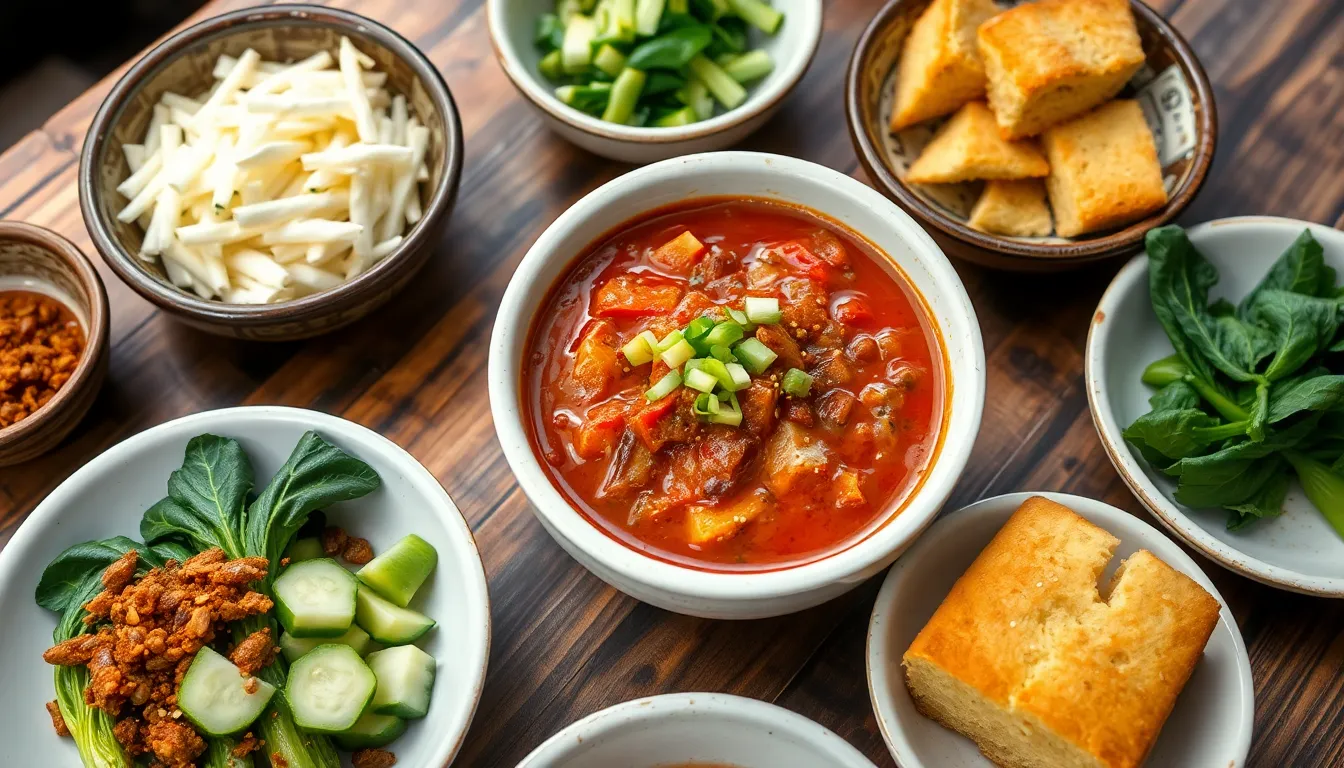
Elevate your miso chili experience with these thoughtfully selected pairings that complement its rich umami flavor and warming spice. Each pairing enhances different aspects of this fusion dish making every bite more satisfying.
Sides That Balance The Heat
Steamed bok choy offers a refreshing contrast to spicy miso chili with its mild flavor and crisp texture. A cucumber salad dressed with rice vinegar brings cooling crunch that cuts through the richness of the chili. Consider serving a small cup of savory broth alongside your miso chili noodles to enhance the overall flavor experience.
Bread Companions
Warm cornbread with honey butter creates a perfect sweet-savory balance against the complex umami notes in miso chili. Crusty sourdough bread works wonderfully for sopping up the flavorful sauce. Japanese milk bread provides an interesting cultural fusion element with its pillowy texture contrasting the hearty chili.
Grain Foundations
Serve your miso chili over steamed short-grain rice for an Asian-inspired meal that stretches the serving size. Nutty brown rice adds nutritional value and a pleasant chewy texture. Quinoa offers a protein-packed alternative that complements the umami flavor of miso.
Fresh Counterpoints
A simple green salad dressed with sesame oil and rice vinegar cleanses the palate between bites of rich chili. Pickled vegetables like daikon or cucumber add brightness and acidity. Shredded cabbage tossed with lime juice provides refreshing crunch and vitamin C.
Beverage Matches
Japanese lager beer cuts through the richness of miso chili with its crisp finish. Full-bodied red wines stand up well to the complex flavors in this dish. For non-alcoholic options sparkling water with lemon brings refreshing effervescence that helps cleanse the palate.
Garnishes That Elevate
Sliced scallions add fresh onion flavor and visual appeal. A dollop of tangy yogurt or sour cream balances the heat while adding creaminess. Toasted sesame seeds sprinkled on top provide subtle nutty flavor and satisfying texture.
Complementary Proteins
Grilled meats particularly pork or chicken take on new dimension when served alongside spicy miso chili. Tofu whether silken or firm absorbs the flavors beautifully when added directly to the chili. Seafood especially firm white fish or shrimp pairs exceptionally well with the savory miso base.
These pairings transform your miso chili from a simple meal into a complete dining experience that balances flavors textures and culinary traditions from both East and West.
The Story Behind This Fusion Dish

Miso chili represents a fascinating culinary crossroads where ancient Japanese fermentation techniques meet global spice traditions. This innovative dish traces its roots to miso’s 1,300-year journey from China to Japan during the Asuka period. Initially reserved for the elite and Buddhist monks, miso gradually evolved into a fundamental Japanese seasoning that now transcends cultural boundaries.
The fusion element of miso chili emerged as part of the natural evolution of global cuisine. Throughout history, colonization, trade, and migration have facilitated the blending of culinary traditions across different cultures. These interactions created natural opportunities for ingredients like miso to meet spices from other parts of the industry.
Nikkei cuisine provides a perfect example of successful miso fusion, combining Japanese culinary techniques with Peruvian ingredients. In these dishes, traditional miso harmonizes with tropical components like chili peppers and hearts of palm, creating entirely new flavor profiles that honor both cultural traditions.
The modern concept of miso chili gained important momentum in the late 20th century when pioneering chefs like Nobuyuki “Nobu” Matsuhisa popularized miso-based fusion dishes. These culinary innovators recognized how the deep umami qualities of fermented soybean paste could complement and enhance the vibrant heat of chili peppers.
What makes miso chili particularly special is the balance it achieves between seemingly opposite flavor profiles. The savory fermented depth of miso creates a complex foundation that elevates the bright, spicy notes of chili peppers. This harmony of flavors delivers a uniquely satisfying dish that feels both familiar and excitingly new.
Today’s miso chili recipes showcase the versatility of this fusion concept. Chefs and home cooks continue to experiment with different miso varieties (white, red, or mixed) paired with various chili pepper combinations to create personalized versions of this globally-inspired dish that connects Japan’s ancient culinary heritage with contemporary cooking styles.
Nutritional Benefits Of Miso Chili
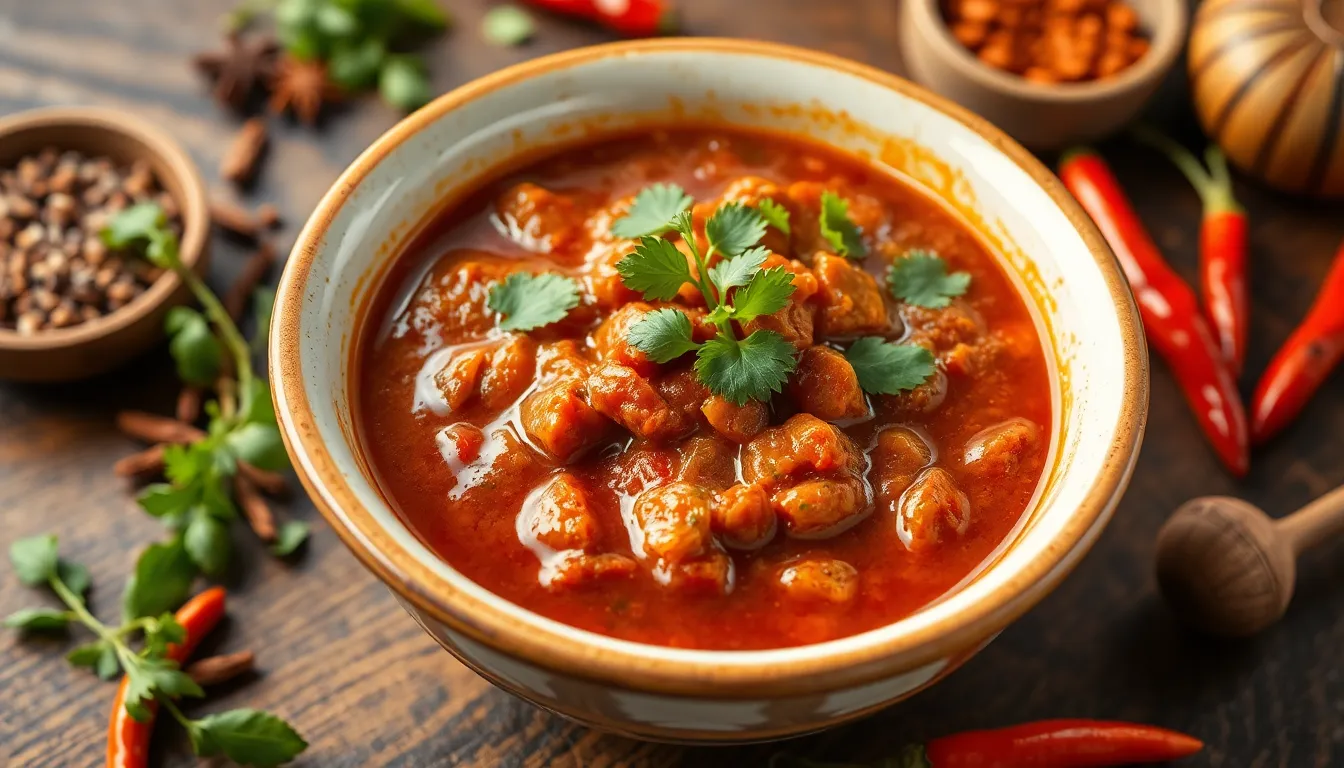
When you enjoy a bowl of miso chili, you’re not just treating your taste buds—you’re also nourishing your body with a powerhouse of nutrients. This fusion dish combines the best nutritional aspects of traditional chili ingredients with the unique health benefits of fermented miso paste.
Miso paste serves as the nutritional foundation of this dish, offering an impressive array of health advantages. The fermentation process creates a probiotic-rich food that supports your digestive system and promotes a healthy gut microbiome. These beneficial bacteria aid in digestion and enhance overall gut function, potentially improving your body’s ability to absorb nutrients from other foods.
The antioxidant content in miso chili is particularly noteworthy. Soybeans, the primary ingredient in miso, contain natural isoflavones that help protect your cells from oxidative stress. This protection is linked to reduced risk of chronic diseases and may contribute to healthier aging.
Miso chili delivers substantial nutritional value with every spoonful. A single ounce of miso paste contains:
| Nutrient | Amount per Ounce |
|---|---|
| Calories | 56 |
| Protein | 3.3g |
| Carbohydrates | 7.4g |
| Fiber | 1.5g |
| Sodium | 1044mg |
| Vitamin K | 8.2µg |
| Manganese | 0.2mg |
| Copper | 0.1mg |
| Zinc | 0.7mg |
| Riboflavin (B2) | 0.1mg |
| Phosphorus | 44.5mg |
| Iron | 0.7mg |
Your body benefits from the efficient nutrient absorption that fermented foods like miso provide. The fermentation process effectively pre-digests nutrients, making them more bioavailable and requiring less digestive effort from your system.
Adding miso to traditional chili creates a protein-rich meal that supports muscle maintenance while staying relatively low in calories. This makes miso chili an excellent option for those monitoring their caloric intake without sacrificing nutrition or flavor.
The vitamin enhancement from miso is another important benefit. The probiotics present in fermented miso contribute to higher levels of vitamin K and several B vitamins by supporting the beneficial bacteria in your gut that help produce these essential nutrients.
Capsaicin from the chili peppers complements miso’s nutritional profile by potentially boosting metabolism and providing anti-inflammatory benefits. Together, these ingredients create a nutritionally dense meal that satisfies both your palate and your body’s needs.
Final Thoughts On Miso Chili
Miso chili stands as a brilliant example of how culinary traditions can blend to create something greater than the sum of its parts. This dish transforms an American classic with Japanese depth while maintaining its comforting essence.
You’ll find yourself returning to this recipe whenever you crave something hearty yet sophisticated. The balance of umami richness from miso with the familiar warmth of chili creates a memorable meal that satisfies on multiple levels.
Whether you’re serving it at a casual weeknight dinner or impressing guests at your next gathering the versatility of miso chili makes it a valuable addition to your cooking repertoire. Try it once and discover how this fusion dish might become your new comfort food favorite.
Frequently Asked Questions
What is miso chili?
Miso chili is a fusion dish that combines Japanese miso paste with traditional chili ingredients. It blends the umami richness of fermented soybean paste with hearty vegetables, protein, and chili spices to create a unique flavor profile that’s savory, spicy, and slightly sweet. This innovative twist on classic chili offers a silky texture and complex taste that sets it apart from conventional recipes.
What makes miso chili different from regular chili?
Unlike conventional chili that relies primarily on tomato-based acidity and heat, miso chili incorporates fermented soybean paste for a complex umami foundation. This creates depth without overwhelming the palate and results in a velvety, silky texture. The miso element transforms ordinary chili into an extraordinary dish that bridges Eastern and Western culinary traditions while enhancing the overall flavor profile.
What are the health benefits of miso chili?
Miso chili offers numerous health benefits. The miso paste contains probiotics that support gut health and enhance digestion. It’s rich in essential nutrients including protein, fiber, and vitamins while remaining relatively low in calories. The combination of miso and chili peppers provides metabolism-boosting and anti-inflammatory benefits. This makes the dish not only delicious but also nutritionally dense and beneficial for overall wellness.
What ingredients do I need for miso chili?
The key ingredients include white miso paste, protein (beans or ground meat), aromatics (shallots, garlic, jalapeños), vegetables (kale, corn, potatoes), traditional chili spices, and broth. Optional toppings like yogurt, avocado, and fresh herbs allow for personalization. The recipe balances traditional chili components with miso to create a complex flavor profile that can be adjusted according to personal preference.
What equipment do I need to make miso chili?
You’ll need basic kitchen equipment: a large pot or Dutch oven, a wooden spoon or heat-resistant spatula, a sharp chef’s knife, a cutting board, and measuring spoons and cups. Optionally, a potato masher for texture adjustment and a ladle for serving. The straightforward preparation process makes this recipe accessible for cooks of all experience levels with minimal specialized equipment.
How do I properly add miso to chili?
Dissolve the miso paste in warm (not boiling) broth before adding it to the chili, preferably towards the end of cooking. This preserves miso’s delicate umami flavor and probiotic benefits. Avoid adding miso directly to the pot or boiling it, as high heat can destroy its beneficial properties and subtle flavors. Stir thoroughly to ensure the paste is fully incorporated into the dish.
Can I make miso chili vegetarian or vegan?
Absolutely! Miso chili is incredibly versatile and works wonderfully as a vegetarian or vegan dish. Simply use a mix of beans (kidney, black, pinto) and vegetables for protein instead of meat. The white miso paste is already plant-based, and you can add optional peanut butter for extra creaminess. This version is particularly nutrient-dense and offers a satisfying texture with all the complex flavors of the original.
How should I store leftover miso chili?
Cool the chili completely before refrigerating in airtight containers. It will keep for 2-3 weeks in the refrigerator, with optimal flavor during the first week. For longer storage, freeze in portion-sized containers for up to 3 months. When reheating, thaw overnight in the refrigerator if frozen, then warm gently on the stovetop or microwave, adding a splash of broth if needed to restore consistency.
What are some creative ways to serve miso chili?
Serve traditionally with toppings like yogurt, cheese, and avocado, or give it an Asian twist by serving over rice with sesame seeds. Pair with cornbread or crusty bread for a hearty meal. Create a build-your-own chili bar for gatherings with various toppings. Repurpose leftovers into new dishes like stuffed peppers or breakfast hash. Balance the meal with lighter sides like salads or pickled vegetables.
Can I adjust the spiciness level of miso chili?
Yes, the spiciness is fully customizable. For milder chili, reduce or omit fresh chiles and use less chili powder. For extra heat, incorporate multiple layers of spice with fresh hot peppers, dried chili flakes, and hot sauce. The miso’s umami qualities help balance even intense heat levels. Taste as you go and adjust according to your preference, remembering that spice levels can intensify as the chili simmers.
